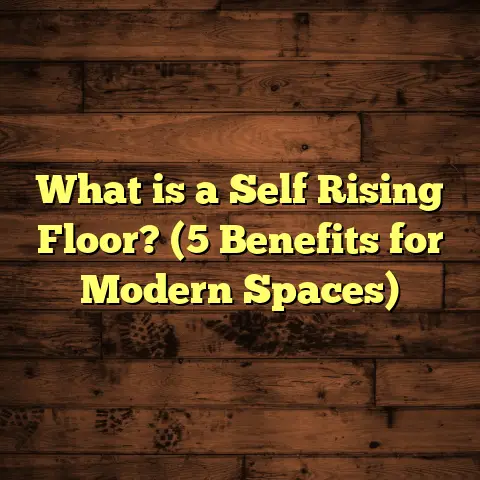What is a Flooring Screed? (5 Key Benefits for Perfect Floors)
I once had a renovation project that turned into a headache because of one overlooked detail. The homeowners had spent a fortune on gorgeous hardwood floors, only to find them uneven and creaky within a few months. I remember walking into the house, stepping onto the floor, and immediately sensing something was off. It wasn’t the wood or the finish—it was the foundation beneath the floor. That’s when I realized how critical a flooring screed is, yet how many people don’t understand its value until it’s too late.
If you’re about to install new floors or renovate an existing space, you might be wondering how to avoid these pitfalls. What’s the secret to floors that feel solid, look flawless, and last for years? The answer lies beneath the surface—in the screed.
What Is a Flooring Screed?
Let’s clear up what a flooring screed really is so you know exactly what we’re talking about. A flooring screed is a thin layer of material applied over your concrete subfloor or base surface to create a smooth, level platform for the final floor covering. This material is usually cement-based but can also include special compounds designed for self-leveling or moisture resistance.
Think of your concrete slab as the rough draft of your floor—it’s functional but not finished. The screed is like an artist’s final brushstroke that smooths out all imperfections and prepares the floor for its final look. Without a screed, you’re basically laying your floor finish on an uneven, porous surface that could lead to cracking, warping, or early wear.
Over the years, I’ve seen some common mistakes homeowners and even contractors make by skipping or rushing this step. The result? Floors that don’t sit right, tiles that crack prematurely, or wood that warps because of moisture issues. Those are expensive problems that could have been avoided with proper screeding.
Types of Screeds You Might Encounter
Before we jump into why screeds are so important, here’s a quick overview of common types:
- Traditional sand and cement screeds: These are mixed on-site or pre-mixed and applied manually. They require skill to get right but are very durable.
- Self-leveling screeds: These are liquid mixtures that flow to fill low spots automatically, creating a flat surface with minimal effort.
- Anhydrite (calcium sulfate) screeds: Known for quick drying times indoors but not suitable for areas prone to moisture.
- Polymer-modified screeds: Enhanced with polymers for extra strength and flexibility, ideal for commercial or heavy-use areas.
I usually recommend self-leveling screeds for DIY projects due to their ease of use, but traditional sand and cement mixes are unbeatable when it comes to long-term durability in high-traffic spaces.
Why Should You Use a Flooring Screed? 5 Key Benefits
1. Achieving a Flawlessly Flat Surface
You might ask: Why is flatness so important? Have you ever tried installing tiles on a floor with waves or bumps? It’s frustrating because tiles don’t bend—they crack.
In one early project I worked on, the concrete slab had multiple uneven spots from poor original pouring. Rather than ignoring it, we applied a sand-cement screed layer that corrected these imperfections by up to 10mm in places. The client was thrilled because the tiles laid perfectly flat and haven’t cracked after three years.
Data backs this up: According to a report by the Tile Council of North America, improperly leveled substrates increase tile failure rates by nearly 30%. These failures aren’t just cosmetic; they can lead to costly repairs and safety hazards.
Even hardwood floors demand flatness. Uneven floors can cause gaps between planks or squeaks as they expand and contract with humidity changes.
So if you want your floors to look professional and stay intact longer, don’t skip this step.
2. Boosting Durability and Lifespan
Screeds do more than just level—they add structural support to your floors. When you walk on a floor without a proper screed, uneven pressure points form. These stress concentrations can cause cracks in tiles or warping in wood floors.
One commercial client I worked with had a retail space with heavy foot traffic and equipment moving constantly. We used a polymer-modified screed that distributed weight evenly across the floor. Three years later, the floors have zero cracks or wear marks—a testament to the screed’s strength.
Research from construction materials testing labs shows that flooring installed over properly prepared screeds lasts up to 50% longer than those installed directly over subfloors without leveling layers.
That means less maintenance, fewer repairs, and better return on your investment.
3. Controlling Moisture for Healthier Floors
Moisture is a silent enemy of many flooring materials, especially wood and laminate. If moisture seeps up from below through porous concrete slabs, it can cause warping, mold growth, or adhesive failure.
I remember once dealing with a beautiful hardwood installation where the homeowner neglected moisture barriers and screeding. Within months, several boards cupped and bowed due to moisture intrusion.
Screeds help because they can include additives that act as moisture barriers or vapor retarders. In some cases, screeds themselves reduce moisture transmission by up to 70%, according to studies by building science institutes.
If you live in humid climates or have ground-level floors without basements, investing in moisture-resistant screeding can save thousands in repairs down the line.
4. Versatility for All Flooring Types
Whether you’re installing tile, vinyl, hardwood, or carpet, a well-applied screed makes your life easier.
I once guided a client who wanted luxury vinyl planks over an old concrete slab riddled with cracks and uneven patches. We used a self-leveling screed that flowed smoothly over these imperfections and created a flawless base in just one day.
Without this step, vinyl planks would have bent or separated at weak points.
Even carpets benefit because uneven floors cause wrinkles or bumps in the carpet padding.
Basically, no matter what kind of flooring you prefer, starting with a properly laid screed gives you peace of mind and professional results.
5. Saving Money Over Time
Here’s a truth from my experience: Cutting corners on floor preparation almost always costs more in the long run.
One client initially hesitated about adding a screed because of budget limits. A year later, they called me back to fix cracked tiles and warped laminate that resulted from uneven subfloors.
Fixing these problems cost nearly three times what applying a good screed would have cost upfront.
Industry data supports this: Projects including proper screeding report up to 40% lower repair costs within five years compared to those without it.
Think of it as insurance—a small investment now prevents big headaches later.
My Own Stories: When Screeding Made All the Difference
I’ve been flooring for over 15 years now, and every project taught me something new about screeding.
Early in my career, I underestimated its importance in some residential jobs. One client wanted quick installation without waiting for drying times after screeding. Rushing led to tiles cracking within months.
That mistake taught me patience—and reinforced how critical it is to respect drying times and preparation steps.
Conversely, I’ve had projects where thorough screeding saved the day. A restaurant client needed new floors fast but couldn’t afford downtime for repairs later. Using fast-drying self-leveling screed met their tight schedule without sacrificing quality.
These experiences taught me: Whether you’re DIYing or hiring pros, invest time in this foundational step—it pays off massively in results.
How To Choose Your Screed: Factors That Matter
Picking the right screed depends on several things:
- Floor type: Tiles need flatness; wood needs moisture control.
- Room conditions: Bathrooms need waterproof options; garages might need heavy-duty strength.
- Installation speed: Some screeds dry faster but may cost more.
- Subfloor condition: Cracked slabs might require polymer-modified mixes for flexibility.
- Budget: Traditional mixes are cheapest but need skilled application.
Here’s how I recommend choosing:
| Screed Type | Best For | Pros | Cons |
|---|---|---|---|
| Sand & Cement | General use | Durable; affordable | Requires skill; slower drying |
| Self-Leveling | DIY; uneven floors | Easy application; fast | Costlier; less durable for heavy loads |
| Anhydrite (Calcium Sulfate) | Indoor dry areas | Fast drying; smooth finish | Not water-resistant |
| Polymer Modified | Commercial; heavy traffic | Strong; flexible | More expensive |
If you’re unsure which suits your project best, ask your contractor or supplier for recommendations based on your exact needs.
Pro Tips for Applying Screed Like an Expert
Want your screeding job done right? Here are some tips I swear by:
- Prep is everything: Clean subfloor thoroughly—dust ruins adhesion.
- Use bonding agents: On older concrete slabs, bonding agents ensure the screed sticks properly.
- Mix carefully: Follow manufacturer instructions exactly—too much water weakens strength.
- Control thickness: Aim for recommended thickness—usually 10mm minimum for durability.
- Be patient: Let it dry fully before laying flooring—rushing causes cracks.
- Consider expansion joints: For large areas, joints prevent cracking from temperature changes.
- Hire pros if unsure: Screeding looks simple but demands skill—especially on big projects.
Case Study: Screeding Saved This Office Renovation
A few years ago, I worked on renovating an office space with existing old concrete floors riddled with cracks and uneven spots. The client wanted polished concrete finish but was worried about costs and downtime.
We decided on applying a polymer-modified self-leveling screed. The process took two days instead of weeks with traditional methods. After curing for three days, we polished the floor as planned.
The result? A perfectly smooth surface with no cracks even after heavy office furniture was moved around for months afterward. The client specifically told me how pleased they were with the durability and look—something they didn’t expect given their initial concerns about budget and timeline.
Common Mistakes With Screeding (And How To Avoid Them)
Even experienced contractors sometimes slip up on this step. Here are typical errors I’ve seen:
- Ignoring drying times: Walking or installing flooring too soon leads to cracks.
- Poor mixing ratios: Too watery mixes lack strength.
- Skipping bonding agents: Screed doesn’t adhere well on old concrete.
- Uneven application: Causes bumps defeating the purpose.
- No moisture testing: Leads to future damage in damp areas.
Avoid these by following guidelines above or hiring experts who know what they’re doing.
Is Screeding Necessary for Every Floor?
Not always—but usually yes if you want quality results. Some floors can go directly over smooth concrete slabs if they’re already level and dry (like certain engineered wood products).
But if there’s any doubt about flatness or moisture issues—which is often the case—screeding is your best bet.
How Long Does Screed Last?
With proper application and maintenance, a good screed lasts decades—often outliving the floor finish itself. It’s designed to be durable under daily wear and environmental conditions.
Final Thoughts: Don’t Neglect This Step
If you want your floors to look amazing and stay strong for years, don’t skip the flooring screed step. It may feel like extra work or cost upfront but its benefits are undeniable: flatness, strength, moisture protection, versatility across floor types, and saving money over time.
From my personal experience in dozens of projects both residential and commercial—this simple layer makes all the difference between floors that impress and those that frustrate.
Before your next flooring project, ask yourself: Is my floor ready underneath? If not, it’s time to bring in the right screed solution—and enjoy perfect floors every time you walk inside your space.





